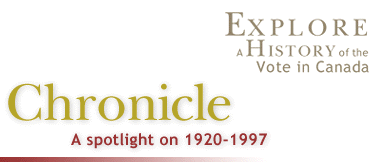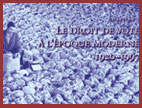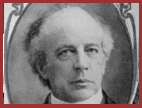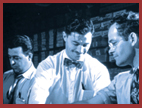 |

|
Progress in fits and starts The first Chief Electoral Officer Judicious recommendations Canada’s five Chief Electoral Officers |

We have seen how the right to vote expanded gradually until the First World War and then how the electorate virtually doubled when women gained the franchise. By 1920 nearly all adults had the vote, though many individuals were still disenfranchised by administrative arrangements, and some groups were disqualified on racial, religious, or economic grounds. At the beginning of the period covered in this chapter, few special measures were in place to protect the right to vote by facilitating voting or encouraging those who had the franchise to exercise it. The conventional procedure for casting a ballot – an elector appearing in person at the polling station on the day set for the election – was the only procedure. Citizens were presumed to
By the end of the period, these assumptions were recognized as faulty and no longer held sway in electoral law and administration. Modernizing the electoral machinery
This chapter traces how the law and election administration have been shaped and reshaped to accommodate the broad diversity that characterizes the Canadian electorate – legislative and administrative innovations that made voting more accessible and convenient, modernized the election machinery, and removed racial and religious disqualifications. In the final section we consider the impact of the Canadian Charter of Rights and Freedoms.
Progress in fits and starts As we learned in Chapter 2, Sir Wilfrid Laurier feared the War-time Elections Act would open an abyss that might not close for generations. Sir Wilfrid was referring to a clash between Canadians of French and British origin, but in the first few years after the First World War, it seemed that the hysteria of 1917 might extend to other groups as well. Anti-German sentiments, for example, did not fade entirely with the end of the war. During social disturbances such as the Winnipeg General Strike of 1919, anti-alien feelings were widely expressed. In the 1920s, hostility to racial and religious minorities swept across North America, and these feelings intensified until 1945. One way this hostility was expressed was in exclusionary electoral laws. But not all developments in the franchise were negative. The War-time Elections Act governed just one election, that of 1917, and Borden’s Conservative government introduced the Dominion Elections Act in 19201. The act established the post of Chief Electoral Officer (CEO) and isolated the incumbent from immediate political pressures by specifying appointment by a resolution of the House of Commons, not by the government of the day. Thus began the tradition of Elections Canada as the independent, non-partisan agency that administers federal elections and referendums.
The new act gave the Chief Electoral Officer the status of a deputy minister and the tenure of a superior court judge, which at that time was for life. During debate on the act, there was opposition to lifetime tenure. J.A. Currie, the MP for Simcoe North, said, "You are only setting up a form of Prussianism when you are appointing officers for life." Other MPs also questioned the value of the office. But many agreed with Norman Ward’s assessment: "a most salutary reform". (Ward 1963, 181)
The first Chief Electoral Officer The first CEO, Oliver Mowat Biggar, presided over what could have been the most chaotic election in years, with the appointment of 75,000 newly minted election officials to supervise a completely revamped system, in which new electors outnumbered those eligible to vote before 1917. Despite these innovations, Biggar recounted in his annual report that the problems involved in the election process itself were comparatively small given the large number of people involved.
An important job of the Chief Electoral Officer was (and is) to prepare a report after each election. The report, required under the Canada Elections Act, gives the CEO a regular opportunity to assess how the electoral law is working and to suggest reforms to Parliament. Many of these have concerned access to the vote – how to ensure that eligible electors can exercise their franchise. This too has had positive effects on the electoral system, as Parliament has adopted and extended many such recommendations.
In his report after the 1921 election, for example, Colonel Biggar recounted the difficulties of electors – particularly women – who had been left off voters lists. He suggested the appointment of more revision officers and advised making more advance polls available. Parliament responded by reducing the number of voters needed for setting up an advance poll from 50 to 15.
Similarly, after the 1925 election, Colonel Biggar pointed out that with the election being held on a Thursday, the advance voting provisions had been of little use to commercial travellers: they were already out on the road when the advance polls opened for the three days preceding the election. In 1929 the law was changed to establish Monday as election day.
Canada’s five Chief Electoral Officers Just five people have held the position of Chief Electoral Officer (CEO) since it was established in 1920: Oliver Mowat Biggar (1920-1927), Jules Castonguay (1927-1949), Nelson Jules Castonguay (1949-1966), Jean-Marc Hamel (1966-1990) and Jean-Pierre Kingsley (since 1990).  1 Oliver Mowat Biggar (1920-1927), the first CEO, oversaw development of federal election administration under the new law. 2 Jules Castonguay (1927-1949) launched the first attempt to establish a permanent voters list. The last vestige of property qualification was eliminated during his tenure. 3 Nelson Jules Castonguay (1949-1966) saw the end of religious discrimination in the law, extension of the franchise to registered Indians, and introduction of the Electoral Boundaries Readjustment Act. 4 Jean-Marc Hamel (1966-1990) implemented many changes in election law and administration, including registration of political parties, establishment of election expense limits, and Charter-related changes. 5 Under Jean-Pierre Kingsley (1990-), Elections Canada continued the reform required to comply with the Charter, entered the information age of computerized election administration and mapping, gained a new mandate to inform and educate voters, and introduced the National Register of Electors and the 36-day election calendar, as well as various changes to make the process more voter friendly. 1 The title was changed to the Canada Elections Act in 1951. |
 |


